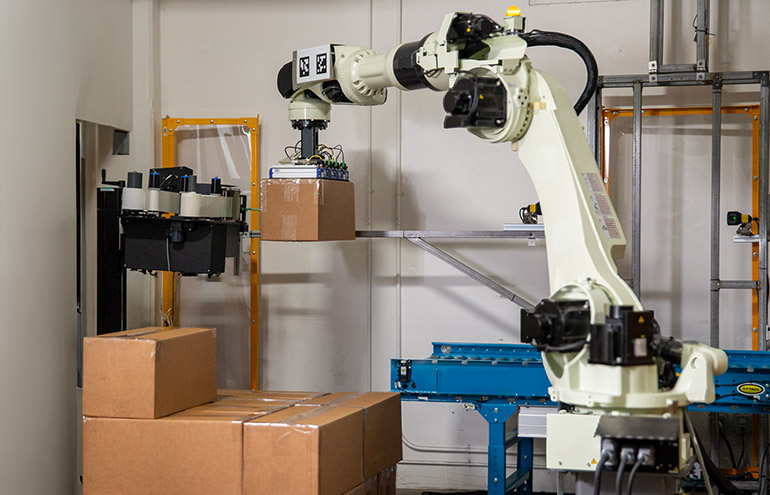|
Listen to this article  |

The Robotic Print and Apply Palletizer is designed to help meet new labeling requirements. Source: Dexterity
Dexterity Inc. today launched its Robotic Print and Apply Palletizer, which it claimed “provides a one-robot workflow to ensure Amazon Routing, SSCC, or SKU barcodes are applied to each case in a pallet before shipment.” The company is targeting third-party logistics, retail, and consumer packaged goods operations that need case-level labeling.
“We’ve seen the manual labeling workflow quickly turn into a bottleneck for our customers, compounding pallet operations challenges such as injury and turnover,” stated Cary Vadenavond, chief revenue officer at Dexterity, in a release. “Dexterity designed the Robotic Print and Apply Palletizer to help customers ensure their shipments go out on time and meet labeling requirements without further burdening their existing warehouse team.”
Dexterity said its “full-stack” robots and artificial intelligence provide robots with human-like dexterity. By automating repetitive tasks, the systems can free employees to focus on higher-value, cognitive work, it asserted.
The Redwood City, Calif.-based company added that its robots can perform complex manipulation in unpredictable environments for applications in logistics, warehousing, and supply chain operations. FedEx recently partnered with Dexterity to test trailer-loading robots.
 Submit a session abstract now to be an event speaker. Submission Deadline: December 15, 2023
Submit a session abstract now to be an event speaker. Submission Deadline: December 15, 2023
Robotic Print and Apply Palletizer lightens manual load
As shippers have adopted new Fulfillment Network Stock Keeping Unit (FNSKU) and other labeling requirements in the past year, they have been forced to add another manual-intensive process to their workflows, noted Dexterity.
The labeling of each case before it is shipped often requires a single team member to take it case off a pallet, add a label, then reload the product on a new pallet. These steps can add complexity, time, and cost to an already stretched workforce, the company said.
Dexterity said its new Robotic Print and Apply Palletizer uses production-fielded technology for palletizing and depalletizing mixed-SKU cases. The system can simplify these operations with single layout, “reducing the cost of automating what is becoming one of the most time-consuming manual tasks in the warehouse,” it said.
The system can accurately identify cases, apply labels according to customer requirements, and replicate pallet patterns. Dexterity added that the Robotic Print and Apply Palletizer can work with a wide variety of pallet and conveyor input/output combinations for inbound, storage, and outbound processes.
According to Dexterity, the new system can achieve a throughput rate of up to 300 cases per hour (CPH), which is approximately 2x faster than the equivalent manual process.

Dexterity said it can double the throughput of case labeling. Source: Dexterity
Dexterity promotes ease of use
Like Dexterity’s previous palletizing and depalletizing releases, the company said customers can deploy the Robotic Print and Apply Palletizer in as little as 48 hours. It said it also provides training, real-time monitoring, and troubleshooting services “ensuring an effortless ramp to production and beyond.”
The company said its AI platform makes the Robotics Print and Apply Palletizer compatible with messy pallets and random SKU cases, allowing it to adapt on the fly as single-SKU pallets change. The software also ensures that the system can adapt to existing customer workflows, minimizing install times and the need for warehouse management system (WMS) or warehouse execution system (WES) integration.
Dexterity added that its regular feature releases add flexibility to its products so that they can be used to their full potential in production. The company plans to host a webinar highlighting its Robotic Print and Apply Palletizer on Dec. 14 at 1:00 p.m. EDT.
Market estimates for palletizing robots vary widely, from $1.47 billion in 2023, according to Future Market Insights (FMI), to $4.13 billion, estimated Fact.MR. The compound annual growth rate (CAGR) could be 5% to $2.39 billion by 2033, said FMI.
Or, the CAGR could be 9.4% to $10.1 billion in 2033, noted Fact.MR. Both research firms agreed that the need for safe and flexible package handling are driving demand.
Credit: Source link


Comments are closed.